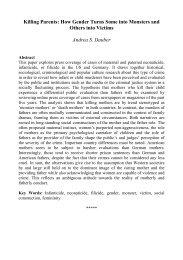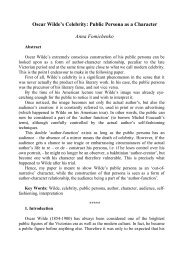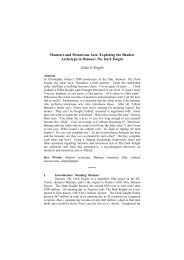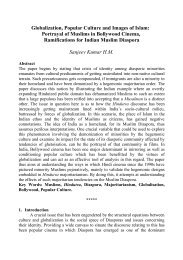The 'green-eyed monster': jealousy and erotic monomania in He ...
The 'green-eyed monster': jealousy and erotic monomania in He ...
The 'green-eyed monster': jealousy and erotic monomania in He ...
You also want an ePaper? Increase the reach of your titles
YUMPU automatically turns print PDFs into web optimized ePapers that Google loves.
that ‘At last the maniac was dead.’ 26<br />
Trollope’s letters reveal that dur<strong>in</strong>g the writ<strong>in</strong>g of <strong>He</strong> Knew <strong>He</strong> Was Right he was <strong>in</strong> communication<br />
with psychologists, collect<strong>in</strong>g material for his fictional case study. Furthermore, there is evidence that<br />
this channel of <strong>in</strong>fluence was reciprocal <strong>in</strong> nature, with doctors read<strong>in</strong>g the novel as pseudo-authentic<br />
account of <strong>monomania</strong>. Trollope wrote to one physician, ‘I am gratified by the attention which your<br />
scientific analysis shews that you have given to the character of the unfortunate man which I attempted<br />
to draw <strong>in</strong> my novel,’ 27 demonstrat<strong>in</strong>g a two-way traffic of ideas between literary <strong>and</strong> scientific<br />
discipl<strong>in</strong>es.<br />
This <strong>in</strong>fluence is particularly <strong>in</strong>terest<strong>in</strong>g s<strong>in</strong>ce it demonstrates that novels were be<strong>in</strong>g read as realities <strong>in</strong><br />
themselves, rather than a mere reflection of them. Elizabeth Langl<strong>and</strong> has argued that novelists <strong>and</strong><br />
novels ‘do not simply reflect the contemporary ideology. Rather, by depict<strong>in</strong>g a material reality filled<br />
with <strong>and</strong> <strong>in</strong>terpreted through ideology, they also expose ideology.’ 28 I suggest that Langl<strong>and</strong>’s argument<br />
may be applied to psychology, as part of a wider argument about Victorian <strong>in</strong>terdiscipl<strong>in</strong>arity or<br />
perhaps more specifically, prediscipl<strong>in</strong>arity. Trollope’s correspondence with doctors, together with his<br />
clear knowledge of contemporary psychological theory, enabled him to expose a character study <strong>in</strong> a<br />
novel as a scientific case study.<br />
Trollope’s writ<strong>in</strong>g follows psychiatrists who <strong>in</strong>sisted that <strong>monomania</strong> stemmed primarily from<br />
personal matters rather than heredity, such as Forbes W<strong>in</strong>slow <strong>and</strong> J. G. Davey. <strong>The</strong> heightened<br />
suspicion <strong>and</strong> physical decl<strong>in</strong>e we observe <strong>in</strong> Trevelyan was central to the new conception of<br />
<strong>monomania</strong> as observed by Davey <strong>in</strong> 1855, when he wrote, ‘the vacillat<strong>in</strong>g countenance <strong>in</strong>dicates the<br />
condition of the dismal m<strong>in</strong>d; the eyes sunk <strong>in</strong> their hollow sockets… the looks restless <strong>and</strong> vacant.’ 29<br />
Galsworthy’s <strong>The</strong> Man of Property (published <strong>in</strong> 1906), set from 1886-7, centres on Soames<br />
Forsyte, a wealthy solicitor <strong>and</strong> art collector, <strong>and</strong> his marriage to the beautiful Irene <strong>He</strong>ron. To the

















